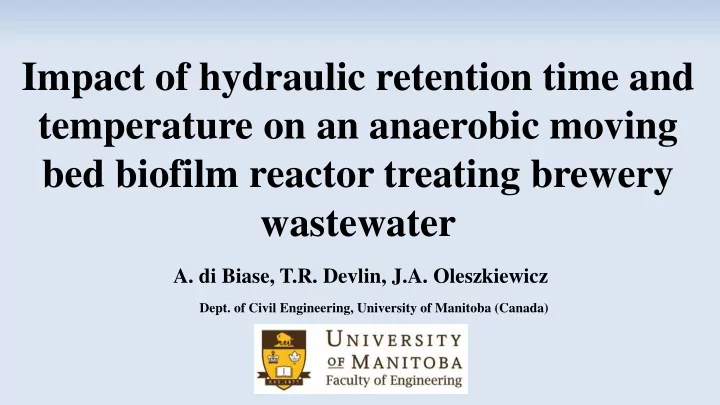

Impact of hydraulic retention time and temperature on an anaerobic moving bed biofilm reactor treating brewery wastewater A. di Biase, T.R. Devlin, J.A. Oleszkiewicz Dept. of Civil Engineering, University of Manitoba (Canada)
High-rate processes for industrial wastewater 1) High settleable sludge aggregates Industry needs: 1 mm Small footprint High capacity 2) Biofilm on high-density carriers Anaerobic digestion requires: 3) Biofilm on packing material Long SRT 1 mm 1
Anaerobic moving bed biofilm reactor www.aqwise.com www.veolia.com www.headworksinternational.com www.mutag-biochip.com 2
Objectives • Examine performance under: • Increasing organic loading (4 to 22 kg sCOD/m 3 d) • Decreasing hydraulic retention time (24 to 6 h) • A range of temperatures (35 to 15 ⁰ C) • Performance measures: • COD removal and surface area loading rates (SALR) • Gas production/composition • Suspended/attached solids • Develop design parameters 3
Brewery wastewater • Rich in organic carbon • Valuable for biogas production Limit for sewer discharge Typical Fort Garry brewery Winnipeg Veneto Brewery wastewater (Canada) 1 (Italy) 2 1 – 3.5 BOD 5 (g/L) 5 0.3 0.25 2 – 6 COD (g/L) 7 0.45 0.5 0.2 – 1 TSS (g/L) 0.4 0.35 0.2 4.5 – 12 4 – 11 5.5 – 9.5 5.5 – 9.5 pH 24 – 30.5 Temperature N.A. - - 1 City of Winnipeg (Canada) bylaw No.92/2010 4 2 D. Lgs. 152/06 (Parte Terza, Allegato 5, Tabella 3) for Veneto Province
Setup – Hydraulic retention time (HRT) 5
Setup – HRT & OLR HRT 24 18 12 10 8 6 (hours) OLR 4 5.5 10 14 21 22 (kg COD/m 3 d) Three reactors (4L): 40 % media fill 1.1 m 2 available surface area 6
Setup – Temperature (T ° C) Operational parameters 15 ° C 25 ° C 35 ° C Three reactors (4L): 50 % Media fill 1.4 m 2 available surface area 7
Performance – HRT Influent ~ 3.5 g sCOD/L 8h HRT 80% Removal 8
Process efficiency – HRT 8h HRT pH drops down 62 % CH 4 Increased alkalinity 32 % CO 2 addition 9
Engineering significance – HRT R 2 = 0.6901 23 46 Process less efficient above 50 g sCOD/m 2 d 10
Attached solids – T ° C 11
UASB Vs AMBBR solids – T ° C Upflow anaerobic sludge blanket * ~ 6.2 g VSS/L at room temperature (19-24 ° C) with organic loading rate of 3 kg COD/m 3 d * Cronin (1998) “Anaerobic treatment of brewery wastewater using a UASB reactor seeded with activated sludge”. Bioresource Technology 64; 33-38. 12
Performance – T ° C Influent 89% 3.5 g sCOD/L 75% 65% Strong correlation R 2 = 0.9966 13
Biogas – T ° C 14
Engineering significance – T ° C 15
Conclusions At organic loading rates above 20 kg sCOD/m 3 d methanogenesis • started to be decoupled from fermentation • 80% COD removal with a methane yield of 0.36 m 3 CH 4 /kg COD rem • Surface area loading rates must not exceed 50 g sCOD/m 2 d At typical brewery wastewater temperature of 28 ° C: • Methane yield of 0.31 m 3 CH 4 /kg COD rem is expected • Surface area loading rates of 11 g sCOD/m 2 d will ensure 80% sCOD removal 16
Questions?
Recommend
More recommend